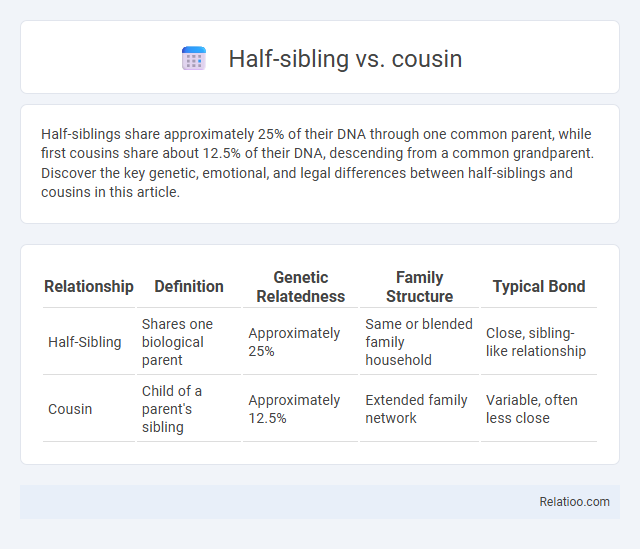Half-siblings share approximately 25% of their DNA through one common parent, while first cousins share about 12.5% of their DNA, descending from a common grandparent. Discover the key genetic, emotional, and legal differences between half-siblings and cousins in this article.
Table of Comparison
| Relationship | Definition | Genetic Relatedness | Family Structure | Typical Bond |
|---|---|---|---|---|
| Half-Sibling | Shares one biological parent | Approximately 25% | Same or blended family household | Close, sibling-like relationship |
| Cousin | Child of a parent's sibling | Approximately 12.5% | Extended family network | Variable, often less close |
Understanding Half-Siblings and Cousins
Half-siblings share one biological parent, either mother or father, resulting in approximately 25% shared DNA, while cousins typically share grandparents and about 12.5% of their DNA. Understanding half-siblings involves recognizing the closer genetic and familial bond compared to cousins, which impacts inheritance and family dynamics. Both relationships are important in genealogical research but differ significantly in genetic closeness and legal considerations.
Definition of Half-Sibling Relationships
Half-siblings share one biological parent, either a mother or a father, distinguishing their familial bond from cousins who share no direct parental lineage but instead share grandparents. This unique genetic connection often results in half-siblings sharing approximately 25% of their DNA, whereas cousins typically share about 12.5%. Understanding your half-sibling relationships clarifies family dynamics and inheritance patterns, emphasizing the direct biological link that sets them apart from cousins.
Definition of Cousin Relationships
Cousin relationships are defined by individuals who share common grandparents but have different parents, making them first cousins. Half-siblings, in contrast, share only one biological parent, either a mother or a father, which distinguishes them from full siblings who share both parents. Your understanding of these family connections is essential for tracing lineage and establishing genetic relationships accurately.
Genetic Similarity: Half-Sibling vs Cousin
Half-siblings share approximately 25% of their genetic material due to having one common parent, whereas cousins typically share about 12.5% since they have common grandparents but different parents. This increased genetic similarity in half-siblings often results in closer hereditary traits and health risks compared to cousins. Understanding the genetic overlap is crucial for family medical history assessments and inheritance studies.
Legal and Inheritance Implications
Half-siblings share one biological parent, which often grants them specific legal rights and inheritance claims under many jurisdictions, whereas cousins typically have more distant legal recognition and limited inheritance entitlements. Your status as a half-sibling frequently affords you stronger probate rights compared to cousins, especially in intestate succession where legal statutes prioritize closer blood relations. Understanding these distinctions is crucial for addressing inheritance disputes and ensuring your rightful claims are protected under family law.
Family Dynamics and Relationships
Half-siblings share one biological parent, resulting in a closer genetic bond and often stronger family dynamics compared to cousins, who share common grandparents but less direct genetic connection. Your relationships with half-siblings typically involve more frequent interaction and deeper emotional ties, while cousin relationships can vary widely depending on family closeness and shared experiences. Understanding these distinctions helps navigate complex family dynamics and fosters healthier interpersonal connections.
Common Misconceptions
Half-siblings share one biological parent, leading to about 25% shared DNA, while cousins typically share a grandparent, averaging 12.5% shared DNA, which often causes confusion in family relationship terminology. A common misconception is that half-siblings and cousins have similar genetic relatedness, but the biological connection is stronger between half-siblings. Understanding these distinctions clarifies inheritance patterns and familial roles within genetic and legal contexts.
Cultural Perspectives on Half-Siblings and Cousins
Cultural perspectives on half-siblings and cousins vary significantly, influencing family dynamics and social roles within different societies. In many cultures, half-siblings are regarded with similar familial obligations and emotional bonds as full siblings, while cousins often hold distinct, sometimes less immediate, relational significance. Your understanding of these cultural nuances can enhance family cohesion and respect for diverse kinship traditions.
Emotional Bonds and Social Interaction
Half-sibling relationships often involve stronger emotional bonds compared to cousins due to shared parental connection and more frequent interactions within immediate family settings. Cousins typically experience more varied emotional closeness influenced by family dynamics, cultural factors, and the frequency of social gatherings. The complexity increases when considering half-siblings on both sides, where blended family structures impact social roles, attachment patterns, and the development of identity within the family network.
Determining Family Roles and Identity
Determining family roles and identity between half-siblings and cousins requires understanding genetic ties and familial lineage; half-siblings share one biological parent, making their genetic connection closer than that of cousins, who share common grandparents but different parents. You can explore genetic testing and family history documentation to clarify these relationships, which significantly impact inheritance rights, social roles, and personal identity. Clear differentiation of half-siblings versus cousins aids in navigating family dynamics, legal matters, and emotional bonds within your family structure.

Infographic: Half-sibling vs Cousin
 relatioo.com
relatioo.com